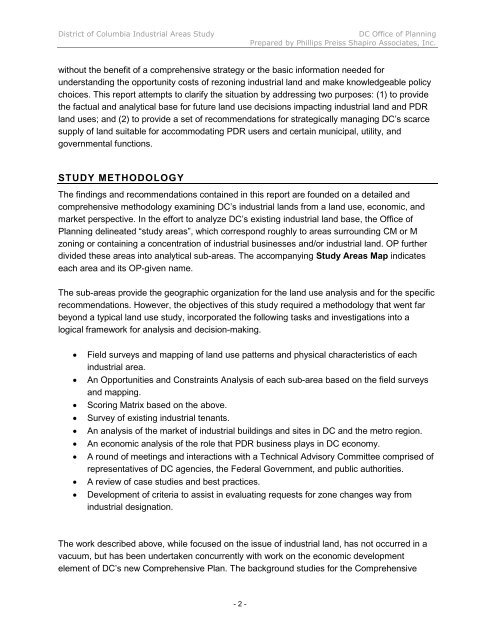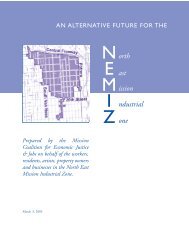INDUSTRIAL LAND IN A POST-INDUSTRIAL CITY District of ...
INDUSTRIAL LAND IN A POST-INDUSTRIAL CITY District of ...
INDUSTRIAL LAND IN A POST-INDUSTRIAL CITY District of ...
Create successful ePaper yourself
Turn your PDF publications into a flip-book with our unique Google optimized e-Paper software.
<strong>District</strong> <strong>of</strong> Columbia Industrial Areas Study DC Office <strong>of</strong> Planning<br />
Prepared by Phillips Preiss Shapiro Associates, Inc.<br />
without the benefit <strong>of</strong> a comprehensive strategy or the basic information needed for<br />
understanding the opportunity costs <strong>of</strong> rezoning industrial land and make knowledgeable policy<br />
choices. This report attempts to clarify the situation by addressing two purposes: (1) to provide<br />
the factual and analytical base for future land use decisions impacting industrial land and PDR<br />
land uses; and (2) to provide a set <strong>of</strong> recommendations for strategically managing DC’s scarce<br />
supply <strong>of</strong> land suitable for accommodating PDR users and certain municipal, utility, and<br />
governmental functions.<br />
STUDY METHODOLOGY<br />
The findings and recommendations contained in this report are founded on a detailed and<br />
comprehensive methodology examining DC’s industrial lands from a land use, economic, and<br />
market perspective. In the effort to analyze DC’s existing industrial land base, the Office <strong>of</strong><br />
Planning delineated “study areas”, which correspond roughly to areas surrounding CM or M<br />
zoning or containing a concentration <strong>of</strong> industrial businesses and/or industrial land. OP further<br />
divided these areas into analytical sub-areas. The accompanying Study Areas Map indicates<br />
each area and its OP-given name.<br />
The sub-areas provide the geographic organization for the land use analysis and for the specific<br />
recommendations. However, the objectives <strong>of</strong> this study required a methodology that went far<br />
beyond a typical land use study, incorporated the following tasks and investigations into a<br />
logical framework for analysis and decision-making.<br />
Field surveys and mapping <strong>of</strong> land use patterns and physical characteristics <strong>of</strong> each<br />
industrial area.<br />
An Opportunities and Constraints Analysis <strong>of</strong> each sub-area based on the field surveys<br />
and mapping.<br />
Scoring Matrix based on the above.<br />
Survey <strong>of</strong> existing industrial tenants.<br />
An analysis <strong>of</strong> the market <strong>of</strong> industrial buildings and sites in DC and the metro region.<br />
An economic analysis <strong>of</strong> the role that PDR business plays in DC economy.<br />
A round <strong>of</strong> meetings and interactions with a Technical Advisory Committee comprised <strong>of</strong><br />
representatives <strong>of</strong> DC agencies, the Federal Government, and public authorities.<br />
A review <strong>of</strong> case studies and best practices.<br />
Development <strong>of</strong> criteria to assist in evaluating requests for zone changes way from<br />
industrial designation.<br />
The work described above, while focused on the issue <strong>of</strong> industrial land, has not occurred in a<br />
vacuum, but has been undertaken concurrently with work on the economic development<br />
element <strong>of</strong> DC’s new Comprehensive Plan. The background studies for the Comprehensive<br />
- 2 -












